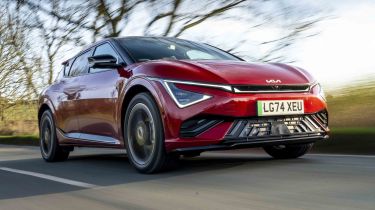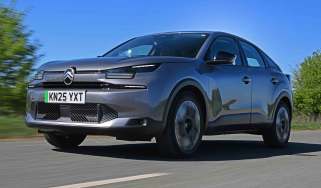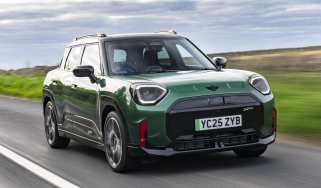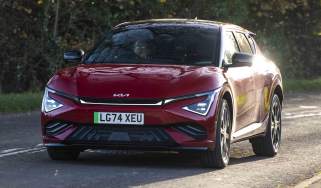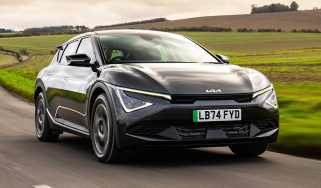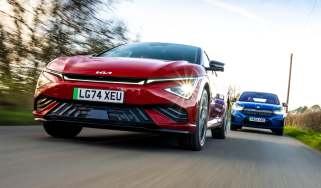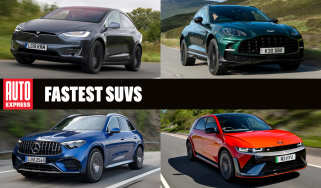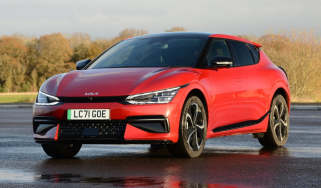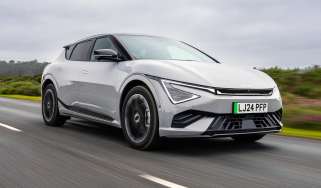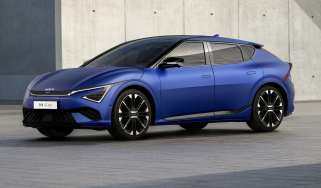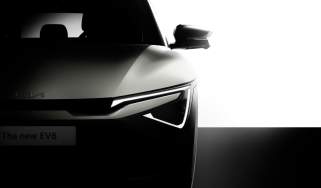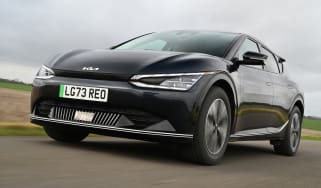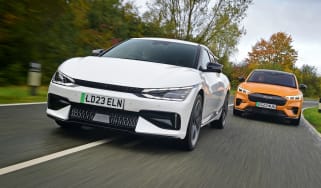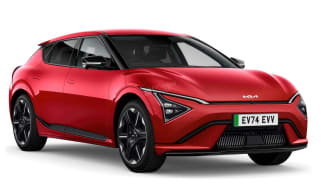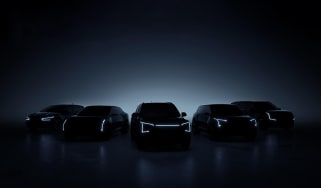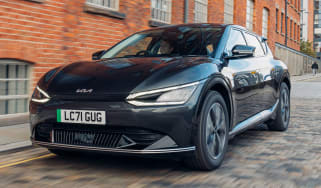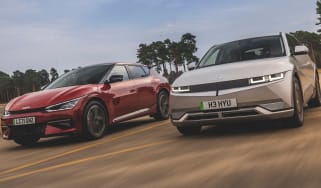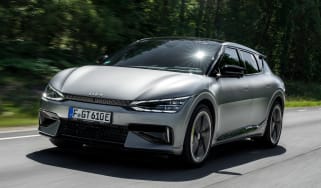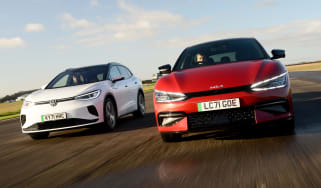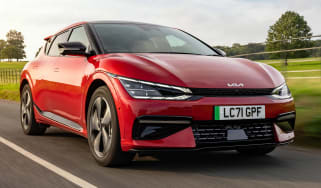Kia EV6 review
The Kia EV6 is a vast all-electric family car, but it can’t disguise its dynamic and packaging compromises

Our opinion on the Kia EV6
Now, more than ever, the Kia EV6 confirms that you can kick your petrol or diesel habit and choose an electric car. With a larger battery, the latest EV6 has more than 300 miles of range, while ultra-rapid charging speeds make pit stops on long trips a breeze. There’s plenty of standard equipment, and even though the EV6 is a few years old, its updated styling is still radical enough to turn heads.
However, while it charges faster than most of its competitors, there are more efficient rivals, such as the Polestar 2, which can go further between charges. There are also more comfortable and practical alternatives to consider, such as the Skoda Enyaq, which offers a more compliant low-speed ride plus a much larger boot.
| Key specs | |
| Fuel type | Electric |
| Body style | Mid-size electric SUV |
| Powertrain | 63kWh battery, 1x electric motor, rear-wheel drive 84kWh battery, 1x electric motor, rear-wheel drive 84kWh battery, 2x electric motors, four-wheel drive |
| Safety | 5-star Euro NCAP (2022) |
| Warranty | 7-years/100,000 miles |
About the Kia EV6
The transition to electric powertrains has been a perilous path to navigate for many manufacturers, but cars such as the Kia EV6 show that the Korean maker has skipped along it more merrily than most of its rivals. Not only is Kia able to churn out new EVs at a staggering rate – the brand aims to have 15 fully electric models on sale across global markets by 2027 – but it has also managed to continue offering cars for those who aren’t ready to make the switch. From the affordable, petrol-powered Kia Picanto to the large, diesel seven-seat Kia Sorento, it’s a range which has something for everyone.
Used - available now
Within the electric line-up, the EV6 marked a significant step beyond what it had offered before. Previous EV versions of the Kia Soul EV and Kia Niro EV helped Kia find its feet with the tech, and they were very convincing cars for their time. But the EV6 used the Hyundai group’s E-GMP platform, complete with hi-tech 800-volt architecture. At its launch, only high-end models, such as the Porsche Taycan, had such an advanced electrical set-up, which promised charging speeds that no similarly priced rival could match.
But in this rapidly evolving electric era, Kia hasn’t stood still, which is why changes to the facelifted EV6 run more than skin deep. Range has been boosted by an 84kWh battery – up from 77.4kWh – while alterations to the suspension, interior and standard equipment complete the upgrade.
Pricing for the latest Kia EV6 starts from around £39,000 for the entry-level Air with a 63kWh battery, while upgrading to the larger 84kWh pack that’s standard across the rest of the range is around £6,300 extra. Next up is GT-Line trim, which is a little over £48,500, while those wanting four-wheel drive will need to stump up around £52,000. The top-of-the-range GT-Line S with four-wheel drive and a heat pump costs more than £58,000. The high-performance EV6 GT hasn’t been revealed in facelifted guise just yet, but you can expect that model to be priced in excess of £62,500.
Throughout the range, Kia has been generous when it comes to kit, and even the entry-level Air specification comes with 19-inch alloys, LED headlights, artificial leather upholstery, heated front seats and steering wheel, twin 12.3-inch curved displays, integrated sat-nav, front and rear parking sensors with a reversing camera, plus Apple CarPlay and Android Auto smartphone connectivity.
Mid-range GT-Line adds a healthy dose of extra tech for a fairly minimal extra cost over the Air. These additions include adaptive headlights, blind-spot detection, safe-exit assist, heated rear seats and fully-electric front relaxation seats, plus wireless phone charging. The top-of-the-range GT-Line S adds an electric tailgate, larger 20-inch alloy wheels, a 360-degree camera system, a customisable head-up display and a 14-speaker Meridian sound system.
Performance & driving experience
| Pros | Cons |
|
|
Although the Kia EV6 sits on the same E-GMP electric car platform as the Hyundai Ioniq 5 and Genesis GV60, the Kia has a sportier feel. There’s MacPherson strut front suspension and a multi-link rear end, which helps to keep things nicely controlled. The EV6 has a slightly stiffer set-up than the Ioniq 5, and it isn’t as tall as the more luxurious GV60, so it benefits from a lower centre of gravity.
The less expensive rear-wheel-drive versions of the EV6 feature a single 225bhp electric motor, while all-wheel-drive versions get an electric motor on each axle, which, combined, puts out 320bhp.
Electric motors, 0-60mph and top speed
The EV6’s dual-motor set-up delivers superb acceleration – 0-62mph takes just 5.3 seconds, and it’s matched to an eager throttle response that’s easy to modulate. But as fun as this is, we feel that acceleration that’s on a par with some serious hot hatchbacks is a little unnecessary for a family car.
For that reason, the standard rear-wheel-drive option – with 225bhp and a 7.7-second 0-62mph time – seems more than good enough for the overwhelming majority of drivers.
Predictably, the EV6 GT is the performance champion. With a 0-62mph time of just 3.5 seconds, this is the version you want if you fancy embarrassing some supercars while on the school run.
Town driving, visibility and parking
Kia has retuned the dampers to address the original EV6’s slightly fidgety ride, but the changes haven’t gone far enough. While it feels a touch more compliant than before, the car’s rear now feels a little out of sync, bumping harshly across uneven surfaces. Rivals such as the Renault Scenic and Ford Capri are similarly firm, but their damping feels more sophisticated.
Imperfections in the road are transmitted through the stiff chassis – especially in GT-Line S trim with larger 20-inch alloy wheels. It’s far from unpleasant, but can’t quite match the Skoda Enyaq for comfort.
The steering in the EV6, although not as light as its Ioniq 5 or GV60 siblings, is pleasingly direct and allows you to accurately place the car when navigating your way through a tight village or along a busy city street. It’s also backed up by good brake pedal feel, with the regenerative braking system blending with the regular mechanical brakes well. It’s particularly adept when the former is left in its auto setting.
Kia’s excellent regenerative braking system offers several levels of braking strength, and can be adjusted on the fly with paddles behind the steering wheel. There’s a one-pedal driving mode called i-Pedal, which is especially good for stop-start traffic because it’s strong enough to bring the car to a smooth stop and hold it in place until the traffic ahead clears, and you can accelerate away.
However, you are very conscious of just how long the EV6 is when driving in tight urban streets. At close to 4.7 metres long, it’s nearly the same length as the brand’s seven-seat SUV, the Kia Sorento. In order to maximise cabin space, Kia has pushed the front and rear axles out as far as possible; the 2.9-metre wheelbase is very long. A side effect of this is that the EV6’s turning circle is quite wide, at 11.6 metres. There are rivals that can turn in tighter and are easier to manoeuvre as a result.
B-road driving and handling
Unlike some family EVs, the Kia EV6 is a lot of fun to drive on twisty roads. In fact, it’s among the most enjoyable electric cars we’ve driven.
Leave the drive mode in Normal, and the EV6 is alert to your commands, which is good because Sport mode can be too frenetic for everyday use. Given the EV6 weighs up to 2,165kg in dual-motor guise (the single-motor version is 2,090kg – around 120kg heavier than before it was facelifted), the sharper throttle and steering responses are a bit too intense in this sportiest setting, and it all becomes a little unbalanced and overexcitable, particularly when travelling on twisty B-roads. In contrast, Eco driving mode can make the EV6 quite slow to get going again after stopping.
The firm suspension means that the EV6 doesn’t roll too much through corners, although at almost 2.2 tonnes, it’s not a car that encourages you to drive keenly. It’s stable and predictable through bends, the balance is neutral, and the grip is decent. The steering is one of the best aspects of the EV6’s dynamics; it’s precise and naturally weighted.
The 577bhp GT model comes with electronically controlled suspension and a limited-slip differential, and feels more agile than the regular EV6.
Motorway driving and long-distance comfort
A long wheelbase means that stability is reassuring at high speeds, and aside from a little road rumble, refinement is great. Kia has added soundproofing around the rear motor for the facelift, which means that even under hard acceleration, motor whine is well isolated from occupants.
The strain of long motorway journeys can be eased by Kia’s Lane Follow Assist 2.0 (LFA) system, which automatically keeps the car in its lane (with constant supervision from the driver). Unlike rival systems, Kia’s steering tech can work independently of the adaptive cruise control, so you can choose for the car to steer itself, maintain speed itself, or both. LFA is standard on every EV6 model.
"Finding a balance between ride and handling can be a head-scratcher for EV engineers. Seeking a comfortable ride yet sufficient body control through corners to contain what is usually a two-tonne-plus mass throws up varying results, even on the same platform. The EV6 uses the same E-GMP set-up as the Hyundai Ioniq 5 and Genesis GV60. Of the three, the Kia has the firmest suspension, the Hyundai the softest, and the Genesis sits between them.” – Alex Ingram, chief reviewer, who tested the revised Kia EV6 against the updated Skoda Enyaq Coupé
| Model | Power | 0-62mph | Top speed |
| EV6 Air 63kWh RWD | 167bhp | 8.7 seconds | 115mph |
| EV6 Air 84kWh AWD | 225bhp | 7.7 seconds | 115mph |
| EV6 GT-Line 84kWh AWD | 320bhp | 5.3 seconds | 115mph |
Range, charging & running costs
| Pros | Cons |
|
|
An even more efficient powertrain than before should mean that the EV6 remains fairly cheap to run, and charging speeds are excellent. Insurance and depreciation are average for the class, but higher-spec models can be expensive to buy in the first place.
Electric range, battery life and charge time
The entry-level EV6 Air ‘Standard Range’ model comes with a 63kWh battery, which is designed to help reduce the starting price of the line-up. It’s the only model that costs less than £40,000, while the official range figure is 265 miles.
All other versions of the Kia EV6 use an 84kWh battery, with the RWD single-motor versions offering the longest range in the line-up – up to 361 miles from a single charge. The AWD system in dual-motor models cuts the maximum range to 339 miles in GT-Line variants (324 miles for the GT-Line S version). The four-wheel-drive, 577bhp Kia EV6 GT has yet to follow the standard model with a facelift, so it has the older 77.4kWh battery that offers a maximum range of 263 miles.
Buyers can add a heat pump to the EV6 to help reduce the negative effects of cold weather in winter on battery range, but it’s only available on the top-spec GT-Line S version. At temperatures reaching minus seven degrees centigrade, Kia states that it should be able to preserve the range to around 80 per cent of what’s possible at 25 degrees by scavenging heat from the coolant system to warm the interior.
During our time behind the wheel of a dual-motor EV6, we averaged 3.4 miles per kilowatt hour – a fair return given the cool conditions during our test and the performance of the powertrain. That gives an overall range of 286 miles. That’s a little shy of the 3.5 miles per kWh that Kia claims it’ll achieve, but this figure should improve on a journey with more opportunities to utilise regenerative braking. The lighter rear-wheel-drive Air and GT-Line models have a better efficiency rating of 3.9 miles per kWh, and in our testing of the previous EV6, these have been the most efficient versions in the range.
Unfortunately, rivals have quickly been playing catch-up to the EV6 both in terms of overall range and efficiency. The 85 version of the Skoda Enyaq is on par with the EV6 for range, while the Long Range Single Motor Polestar 2 is significantly better, and manages more than 400 miles to a charge, averaging 4.2 miles per kWh.
However, few can match the speedy rapid charge times of the EV6. As with its Hyundai Ioniq 5 and Genesis GV60 siblings, the EV6 uses an 800V charging system, so if you can plug into a 350kW ultra-rapid charger, a 10 to 80 per cent top-up takes just 18 minutes for both the 63kWh and 84kWh models. When utilising a 7.4kW home wallbox, it’ll take just under 10 hours to refill the 63kWh model, and a little under 13 hours to fully replenish the 84kWh version.
| Model | Battery size | Range | Insurance group |
| EV6 Air RWD Standard Range | 63kWh | 361 miles | 29 |
| EV6 Air RWD | 84kWh | 361 miles | 34 |
| EV6 GT-Line AWD | 84kWh | 324 miles | 40 |
Insurance
Insurance groups range from 29 for the entry-level Air with the small battery to 40 for the dual-motor version of the GT-Line S. That means the Air sits one group higher than the (more powerful) Enyaq Coupé 85 Edition, and the GT-Line S is two groups higher than even the sportiest Enyaq, the vRS.
Tax
All models in the EV6 line-up bar the entry-level 63kWh Air breach the £40,000 mark, so they are subject to the vehicle excise duty (VED) surcharge. That means rather than paying the standard VED rate of £195, owners will pay £620 per annum for years two to six.
Company-car drivers will also enjoy the 3 per cent Benefit-in-Kind (BiK) rate that the EV6 currently attracts.
Depreciation
The EV6 is predicted to hold on to around 47 to 48 per cent of its list price over a typical three-year/36,000-mile ownership period. This is, on average, a little better than the Hyundai Ioniq 5, which ranges from 43 to 48 per cent over the same period. On the other hand, the Renault Scenic holds on to its value slightly better, maintaining between 53 to 54 per cent over the same three-year stretch.
To get an accurate valuation on a specific model check out our free car valuation tool...
Interior, design & technology
| Pros | Cons |
|
|
All EV6s are well equipped. The entry-level Air model is more than ready for family life, with standard kit that includes climate control, heated front seats and steering wheel, dual-screen setup, integrated sat-nav, wireless Apple CarPlay and Android Auto connectivity, numerous USB ports for connecting devices, front and rear parking sensors and a reversing camera.
For an extra £3,000, GT-Line trim brings sportier exterior and interior styling, and adds blind spot monitoring with a safe exit assist system, electric front seats, wireless phone charging, and adaptive headlights.
The top-spec GT-Line S version offers niceties such as bigger 20-inch alloys, a tilt/slide sunroof, a head-up display, a 360-degree camera system, an upgraded 14-speaker Meridian audio set-up and a more advanced suite of driver-assistance technology.
Interior and dashboard design
Interior design was always one of the EV6’s strong suits, so it’s no surprise to see that Kia hasn’t changed much for the facelift. The cabin is dominated by two 12.3-inch displays that wrap around the driver. Combined with a raised centre console, with a neat rotary dial for switching between Drive, Neutral and Reverse, the driver feels cocooned – in a good way – in an otherwise airy interior.
The only significant change between old and new is a fresh steering wheel in the higher trim levels, with a drive-mode button in the centre of its lower spoke.
Materials and build quality
The interior feels smart and up-to-date, with cabin materials of sufficient quality for a £45k-plus family car. There’s also a further nod to sustainability by offering artificial leather upholstery as standard. The updated EV6 has replaced the piano black trim used extensively before with a matt-textured finish, which not only looks classier, but is less susceptible to scratches – a real boon to anyone who regularly wears rings or often puts their keys down on surfaces.
Taking a leaf out of Volkswagen’s book, the front door pockets are flocked in order to prevent items from rattling as you drive down the road.
Infotainment, sat-nav and stereo
The twin, gently curved 12.3-inch screens in the EV6 look fantastic, work well and offer clear graphics. Kia’s infotainment system is easy to use, the wireless smartphone links for both Apple CarPlay and Android Auto, and it all works seamlessly, while the touchscreen display is responsive. It’s all laid out well, and the menus make sense, plus we like the use of black backgrounds, because it reduces eye strain at night. Meanwhile, the driver’s display provides all the information you need.
The standard audio included with Air and GT-Line trims is provided by a six-speaker set-up, while GT-Line S and above come with a 14-speaker Meridian premium audio system. Only the entry-level Air trim misses out on a wireless phone charging pad.
With such a huge battery, it’d be a shame not to make more versatile use of it than simply fuelling the car, which is why the EV6 also features a three-pin plug socket. This means that in addition to the five USB ports dotted around the cabin, it’s also possible to run more power-hungry appliances from the outlet, which is located at the base of the rear seat bench. The same Vehicle-to-Load tech also works from the car’s charge port; a special adapter can be bought from Kia for a little over £300.
“The styling of the facelifted EV6 has divided opinion among the road test team. I’m quite a fan, though; I always felt that the big, triangular lights of the original EV6 looked a bit out of place with the Kia’s rakish body shape and slim LED lighting. To me, the wild angles of the updated lamp units are a much better fit with the car’s distinctive profile. The steeply raked windscreen and bigger wheels mean that, regardless of trim level, it’s one of those cars that looks like it’s going fast even when it’s parked.” – Alex Ingram, chief reviewer, who tested the revised Kia EV6 against the updated Skoda Enyaq Coupé
Boot space, comfort & practicality
| Pros | Cons |
|
|
A mix of a low roof and a high boot floor means the EV6 isn’t as spacious inside as its exterior dimensions will have you believe.
Dimensions and size
As with the Hyundai Ioniq 5, the EV6 is a surprisingly big car in the metal. At 4,680mm long, 1,550mm tall and 1,880mm wide, the EV6 is 31mm longer than a Skoda Enyaq, although the width is virtually identical. It’s also 66mm lower than the Enyaq, which helps give the Kia its sporty, dynamic look. The 2,900mm wheelbase is actually longer than the Audi A8, meaning there’s plenty of room inside.
| Dimensions | |
| Length | 4,680mm |
| Width | 1,880mm |
| Height | 1,550mm |
| Number of seats | 5 |
| Boot space | 490-litres (480-litres for AWD models with Meridian sound system) |
Driving position, seats & space in the front
While its rakish looks mean the EV6 looks less SUV-like than many of its rivals, it does come at the expense of headroom. Some taller testers felt like they were sitting too close to the roof, even with the seat mounted in its lowest position. That aside, there is plenty of adjustability in the front seats and the steering wheel. Both a six-foot driver and front passenger should have no issue getting comfortable in the front of an EV6, though.
While the Ioniq 5 chooses to emphasise the amount of space it offers, the EV6 separates the driver and front passenger with a centre console, but it’s not so wide that you’ll be banging your knee into it all the time or tall enough to make you feel entombed within the cabin. You won’t sit as low as you do in some electric saloons, such as a Tesla Model 3, for instance, but the driving position seems more enclosed because of its steeply raked windscreen and high centre console, giving the EV6 a sportier feel than the Ioniq 5.
GT-Line cars and above include Kia’s Premium Relaxation Seats, which can recline when the vehicle is charging to provide the driver with a more comfortable position to take a nap if they feel tired.
Storage space is plentiful, thanks to big door bins (carpeted to stop small items rattling about) and a two-tier centre console which has cup-holders and smartphone charging on top, and a deep cubby below.
Seats & space in the back
Interior space is a mixed bag in the back of the EV6. Kneeroom is immense – among the best of any car we’ve measured – but this is balanced out by disappointing headroom. It’s possible to recline the backrests a little, which means a more slouched position can take advantage of the room ahead.
There are USB-C charging ports built into the sides of both front seats, so there should be no squabbling between those in the rear about who gets to charge their devices. Parents with children who need child seats can utilise the two ISOFIX points on the outer positions of the second row, although the points aren't that easy to locate and fix a seat to.
Boot space
Behind those back seats is a boot with a huge floor area, but it is also shallow. As a result, the 490 litres of volume on offer (or 480 litres if the Meridian subwoofer is fitted) is fairly average for a car so large on the outside. Dog owners might be better served by a rival with a full SUV bodystyle, such as a Volkswagen ID.4 or Ford Explorer.
Fold the rear bench down, and the overall volume increases to 1,300 litres, leaving only a small step up from the boot floor to the 60:40-split seat backs. Kia also provides a ski hatch for loading long, thin items.
Rear-drive cars benefit from a 52-litre storage compartment under the bonnet, while this space is reduced to 20 litres in all-wheel-drive versions. Either way, the EV6’s front storage is good for keeping your charging cables out of sight and in an area away from your luggage. Rivals such as the Renault Scenic and Volkswagen ID.4 provide underfloor stowage, which might be an issue if you have stuff in the boot that needs to be removed in order to access the cables.
Towing
The maximum braked trailer towing weight for the EV6 has been increased from a decent 1,600kg to 1,800kg, which is far more impressive than the disappointing 1,200kg of the Volkswagen ID.4 GTX or the 1,400kg of the four-wheel-drive 85x Skoda Enyaq.
The EV6 should be more than capable of pulling a decent-sized trailer or a small-to medium-sized caravan. However, we'd always advise double-checking your trailer’s weight before hitting the road.
“A flat floor and plenty of elbow room make it reasonable for a third passenger in the back of the EV6, but while large doors make it easy to manoeuvre a child seat into position, the Isofix mounts are more awkward to reach than in some rivals.” – Alex Ingram, chief reviewer, who tested the revised Kia EV6 against the updated Skoda Enyaq Coupé
Reliability & safety
| Pros | Cons |
|
|
The Kia EV6 didn’t feature in our most recent 2024 Driver Power owner satisfaction survey, although it did do well in our 2023 poll, securing seventh place with glowing praise for its powertrain, ride, handling and smoothness, as well as the number of safety systems, child-friendly features and rear legroom. Kia achieved a third-place finish out of 32 brands in our 2024 Driver Power customer satisfaction survey, with owners loving their cars’ value for money and infotainment.
Euro NCAP awarded the EV6 a five-star safety rating in May 2022, with the all-electric family car achieving a 90 per cent rating for adult protection and 86 per cent for child passenger protection. For the facelift, Kia reinforced the B-pillars, which should enable it to score highly against NCAP’s ever-more stringent testing criteria. Also new is the ability to mute the speed limit warning bong more easily. Rather than delving into an infotainment menu to disable it, the driver can push and hold the volume dial on the steering wheel for three seconds.
Along with smart cruise control and a rear view camera, Kia’s family EV includes a host of active safety systems: Forward Collision Avoidance Assist uses a front radar to monitor for possible hazards, such as pedestrians, cyclists or other cars, before providing a warning and then automatically applying the brakes to help avoid or mitigate a potential collision. There are also systems designed to help keep you in your lane and tech that will sound a warning if it detects any loss of attention or driver fatigue.
The top-of-the-range GT-Line S trim has a more advanced highway driving assist system that helps to centre the car within your lane, and even change lanes for you, provided the blind spot system has determined the coast is clear.
| Key standard safety features | Euro NCAP safety ratings |
|
Buying and owning
- Best buy: EV6 84kWh Air RWD
This is the 84kWh model that offers the best range of all from the line-up. It also has the smaller 19-inch wheels that should help to mitigate the EV6’s firm ride, while standard kit is still generous, even if some of the more cutting-edge tech is missing.
The Kia EV6 has a seven-year/100,000-mile warranty — one of the longest and best factory warranties in the business, especially when compared with the three years of coverage you get with a Volkswagen ID.4 or Skoda Enyaq, while the Tesla Model Y and Hyundai Ioniq 5 get four-year and five-year warranties, respectively.
There is also eight years’ cover for the battery pack, which guarantees that the level of charge will stay above 70 per cent of its original capacity during that period, but the EV6 only comes with one year of roadside assistance.
The EV6 only needs to be serviced once every two years or 20,000 miles, whichever comes first. Both the Skoda Enyaq and Volkswagen ID.4 can also go two years between garage visits, but you can cover an unlimited mileage during that time.
Kia offers interest-free instalment plans for servicing costs. You pay 25 per cent up front, with zero per cent interest on the remaining balance for 3 months.
Kia EV6 alternatives
The Kia EV6 is more of a sporty family EV crossover than a traditional SUV, but it still stands against plenty of capable competitors. Not only does it have its own Hyundai Ioniq 5 and Genesis GV60 siblings to contend with, but there are also the likes of the Ford Mustang Mach-E, Nissan Ariya, Renault Scenic E-Tech, Skoda Enyaq, Toyota bZ4X, and Volkswagen ID.4.
This competition is already strong, but Kia also has upmarket ambitions for its EV6, which brings additional rivals such as the Audi Q4 e-tron, Polestar 2 and Tesla Model Y into the mix.
Frequently Asked Questions
The Kia EV6 is a capable electric family car that offers a sporty driving experience, sharp looks and lots of standard kit. However, more practical alternatives are available, and there are others with even greater driving range, too.
